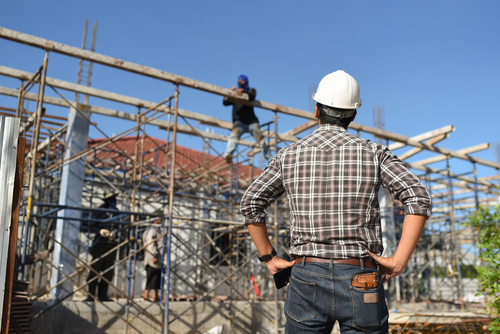If you work in the construction industry or a related field, you have the right to work in a safe environment, free of hazards, and with the necessary equipment to avoid risking your life.
Reporting Unsafe Working Conditions Can Help Your Case
Unfortunately, work accidents often happen because your right to a safe environment is not protected, the necessary precautions are not taken, or unsafe working conditions are not eliminated.
Examples of Unsafe Working Conditions on Construction Sites
According to the Occupational Safety and Health Administration (OSHA), some of the most common accidents at construction sites include falls from heights, being struck by objects, getting caught in or between objects, and electrocutions.
Workers can take steps to avoid injuries, but their safety often depends on their employer’s ability to address dangerous conditions when they arise.
The most frequent construction job site hazards are:
- Lack of fall protection. Workers should be protected from falls, slips, and trips on construction sites and should not work at heights without protection or around hard-to-see hazards
- Unsafe scaffolding. Poor Scaffolding can lead to injuries from scaffolding accidents. Scaffolding should never be overloaded, have inadequate support, be poorly maintained, or have platform hazards.
- Hazardous materials. Construction workers may often be exposed to unsafe materials like lead, asbestos, chemicals, and heavy metals. This requires proper protection and handling procedures.
- Noise. Prolonged, unprotected exposure to loud construction-related noises creates an unsafe workplace.
Employers Have a Duty to Make Work Safe
Employers must execute proper inspections daily to prevent injuries and illnesses. Employees should speak up and report existing hazards at work sites that can endanger the lives of fellow employees and others.
Many workers fear reporting these issues because they fear retaliation from their managers or employers. Fortunately, the State of New York has tools that workers can use to report unsafe working conditions anonymously.
How Employees Can Report Unsafe Conditions
Suppose you are working on a construction site and notice some building materials are not properly secured. You and other workers risk serious injury if those materials fall over or spill.
Workers can report hazardous conditions to a supervisor. This action can help eliminate hazards quickly without taking the issue outside the organization.
However, if your supervisor does not act on your report to eliminate dangerous conditions, there are a few agencies you can anonymously file a complaint:
- NYC Department of Buildings: You can report unsafe conditions for the public and construction workers with the NYC DOB hotline or online reporting system. These conditions could include excessive debris, work not following the approved plans, working during limited hours, or lack of fencing.
- OSHA: You can report violations of the OSHA Act (1970) to the federal government with OSHA’s online complaint system. You can call the OSHA hotline at 800-321-OSHA (6742) for life-threatening violations.
What You Need to File for Working Conditions Complaint
Filing a complaint is as simple as filling in some boxes on the complaint forms, but it’s crucial to understand what’s relevant to the report.You will need the establishment’s name, the worksite’s address, a description of the hazard, the hazard’s location within the site, your employment status with the team, and your name and telephone number.
When an agency responds to the complaint, you can indicate whether you want your name revealed, but you can remain anonymous. While the forms do not include options to attach photographs or video, it could support your case to keep those as evidence.
What Happens After a Complaint is Filed
If a written request meets OSHA’s requirements to warrant an inspection, the agency will contact the employer and describe the allegations in the complaint. They will then follow up on that phone call.
The employer must respond in five days to describe what action was taken to correct the hazard. If the correction is enough, the agency will not conduct an inspection, and the employee who submitted the complaint will receive a copy of the employer’s response.
The complainant can request an onsite inspection if unsatisfied with the employer’s response. OSHA prioritizes inspections for hazards creating imminent danger, then looks at reported fatalities or catastrophes (incidents resulting in three or more employees being hospitalized), then referrals or complaints.
Employers Get the Chance to Address Hazards
Before you report a hazard, let your supervisor know about it. This solution could be more effective than waiting for a safety agency to act.
As attorneys who routinely assist construction workers and others in the trades, we see unnecessary harm and loss frequently happen because unsafe conditions are ignored or unreported. We urge workers to report dangerous conditions. Your safety and that of your co-workers may depend on you taking responsibility.
It’s important to remember that false statements or representations can be punished with fines and incarceration — up to $10,000 and six months of imprisonment.
Legal Options for Injured Workers
Your legal options after a construction accident largely depend on the circumstances. In most cases, construction workers hurt on the job are eligible for workers’ compensation, and families of workers killed in construction accidents likely qualify for workers’ death benefits.
However, an injured worker may be entitled to compensation from a party other than their employer if this third party contributed to the unsafe condition and the accident.
Injured workers may be entitled to seek damages against parties such as:
- Independent contractors and vendors
- Equipment manufacturers and distributors
- Property owners
Reporting Unsafe Conditions Benefits Legal Action
After a complaint is made, the employee cannot be fired, demoted, or retaliated against. If you or a loved one has recently filed a complaint with OSHA and their employer retaliated, that would be a violation, and a lawyer can pursue a civil claim.
Reporting dangerous conditions creates documentation that may point to a pattern of employers permitting dangers on the job site. The report could reveal how an employer or third party had a chance to correct the issue but failed to do so.
If you are a construction worker injured because your employer or a third party failed to follow the legal requirements for reducing unsafe conditions or ignored a valid report, it’s best to discuss the details with a lawyer.
Contact HKD for Help Reporting Unsafe Working Conditions
Hecht, Kleeger & Damashek, P.C. has helped numerous workers and their families after worksite incidents. The team knows New York and federal construction laws and is prepared to hear your story and work on your case. We will guide you throughout the process, keeping you informed and current on your case’s progress.
Call (212) 490-5700 or use our to schedule your free consultation.


